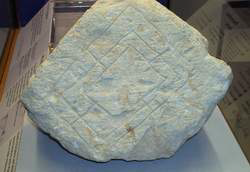One male skeleton was discovered, not in the graveyard, but just inside one of the houses, at the level where the floor would have been. Maurice Beresford has suggested that the man may have been a tramp, crushed when rubble and masonry fell on him. He would like to give the man the title of the Last Villager.
In addition to human skeletons the remains of many animals, domestic fowl, and fish have been found at Wharram Percy. Sheep and cows were the main types of livestock. The remains of pigs have been found, but in low quantities. The fact that bones from all parts of cattle have been found has been taken to indicate that butchery took place within the village. As well as providing meat the livestock would have been used for the production of leather and wool, and selected bones and horns would have been turned into tools.
Other finds include the remains of oxen and, in large quantity, horses. The bones of oxen and horses often bear marks characteristic of animals that have been use to draw heavy loads. Cats and dogs were kept, probably more for their usefulness than as pets. Dogs would have been working animals, while cats could keep the mice and rat population under control.
Artefacts from Wharram Percy reveal other aspects of daily life, for example:
- Small hinges and keys from chests and caskets show that possessions regarded as valuable would have been stored securely.
- Dress fittings provide information about clothing and the way it was worn.
- Hooks, used for hanging clothes and other belongings to the ceiling or wall.
- Pottery came from pots and bowls used in food preparation and serving. Pottery found in two houses were fragments of jugs imported from France and the Mediterranean.
- Candle holders, used to provide illumination during the hours of darkness.
- Spindle whorls, needles, thimbles, and scissors, used in spinning and sewing.
- Items used in making music or playing games, such as bone flutes, dice, and a stone for Nine Men’s Morris.
